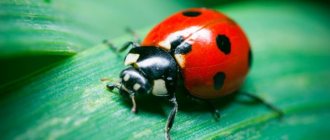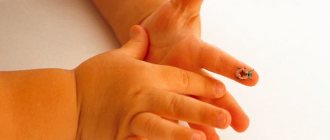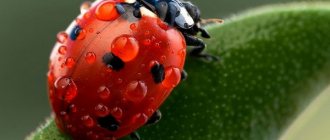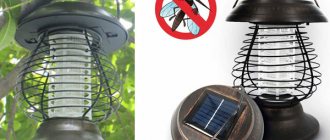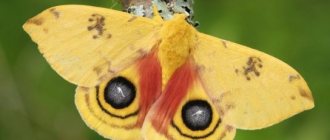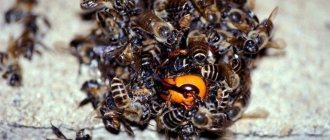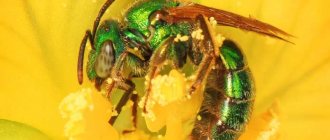What is the relationship between ladybug and aphid. Why is ladybug considered the best remedy against aphids? What you need to know about these insects. How gardeners attract ladybugs to their plots. Popular beliefs. Facts about ladybugs.
We are all familiar with such cute insects as ladybugs. They are capable of not only charming with their rather bright appearance, but are also capable of bringing great benefits to gardeners, as they are ideal assistants in pest control.
It is worth mentioning that for a long time entomologists have been observing the relationships of ladybugs with other insects. It was discovered that the ladybug and the aphid are not on friendly terms. The ladybug destroys the pest, which has become the reason for the widespread use of beneficial insects in agriculture.
Pests
A pest such as aphids is a small, sedentary insect. Adults grow to a maximum length of 8mm. The pest's diet consists of plant sap.
The mouthparts consist of a proboscis, with which they easily pierce the leaf plate and suck out the juice. Aphids secrete a very sweet and healthy substance - honeydew, which ants love. Therefore, very often, when infested with aphids, an anthill is observed in the area.
This small pest is a carrier of dangerous diseases that lead to the death of plants.
They live in fairly large colonies and prefer a mild and warm climate. There are winged and wingless representatives. In autumn, females lay eggs in the bark of trees, near the buds, where they easily survive the winter.
With the arrival of warmth, wingless individuals emerge from the eggs, which attack young plants and begin to actively feed. They can lay offspring without mating, so intensive population growth is observed.
By mid-summer, females with wings are born, which fly to other plants and create new colonies. It is their clutches of eggs that can overwinter, and in the spring everything repeats again.
Lifestyle of a dangerous pest
Their body is either transparent or takes on the color of the plant being consumed. All aphids feed on the sap of plants, destroy their foliage, interfere with its growth and development, and can infect the plant with a virus, which will destroy it (you can find out more about what aphids feed in nature here).
In addition, aphids are divided into winged and wingless. Aphids reproduce very quickly and live in large colonies. A warm and humid climate is most acceptable for them, only in it they reproduce successfully. Aphids feed on young shoots and green leaves. And their favorite shoots are viburnum, linden and plum.
Traces of their vital activity are loved by ants. They are ready to faithfully follow and protect their supplier of the delicacy. Protect from winter frosts in your home, anthill, or from attacks from ladybugs and lacewings. You can learn more about the symbiosis of ants and aphids here.
Ladybug
Ladybug activity begins in the spring and continues until late autumn. As a rule, in those places where they spend the summer, they remain for the winter, hiding under fallen leaves, in the bark of trees, under stones.
But there are also ladybugs that do not stay in one place, but migrate. These insects do not live in colonies; they prefer to lead a solitary lifestyle. But before the onset of cold weather, when they are about to fly or winter in place, they gather together in groups. Mass gatherings can also be observed during the mating season.
These insects are among the first to wake up after a long winter. It is enough for the air temperature to reach +10°, so they can be observed very early in the spring. Life expectancy is on average 10-12 months, in rare cases representatives can live up to 2 years, this largely depends on the availability of food.
The size of these bugs is 4-10 mm and they live alone. When they are on the ground, their wings protect them from predators. In 1 second, this bug can make up to 85 strokes, for this reason most vertebrates, as well as birds, avoid it.
In addition, even tarantulas and lizards do not dare to hunt a ladybug. Protection is also provided by a yellow liquid with an unpleasant odor, which they secrete when in danger.
You can meet them in the steppes, forests, forest edges, and gardens. They fly quite high above the ground. In mid-spring, the mating season begins, and at this time the female emit a specific smell that attracts males. The females then lay eggs in the foliage. In winter they gather in groups and hibernate together.
The life cycle consists of the following stages of development:
- Egg.
- Larva.
- Doll.
- Imago.
Once the larva emerges from the egg, it is very similar to an ordinary pest beetle, but if you examine the individual, you can see barely noticeable red spots on the sides, which give the insect its identity.
For habitat they choose grass meadows, shrubs, and grain crops. They are predators, so they search for aphids, which are their favorite food. In the case when she does not find aphids, her diet may consist of spider mites, small caterpillars, whiteflies, scale insects, and scale insects.
How and where do they winter?
As mentioned earlier, with the onset of autumn, some insects cluster in large groups, each of which numbers up to a million individuals. Initially, they look for secluded places (wood, dry leaves, stones, abandoned buildings, etc.), then they move there and wait for the arrival of spring. Other species, on the contrary, prefer to leave their usual habitats for the winter, flying like birds to the southern corners of the planet.
Attention! If you find “sleepy colonies” of insects, you should not disturb them. If they are somehow in the way (for example, they are in a barn, bathhouse, or some other place that will be used in the future for household needs), you need to carefully put them in a jar and move them to a comfortable place where they can safely spend the winter
There are species of beetles that fly away in flocks to winter in southern latitudes. Recently, features of adaptation to the environment have become not only bright colors or toxic liquid released when dangerous. Their group aggregations are becoming more and more observed. This is still inexplicable, but the spectacle is colorful.
If “sleepy colonies” are discovered, do not disturb them. It’s better to think about how many pests will be destroyed in the future. Move them to a comfortable place, having previously collected them in a jar, let them calmly finish their hibernation.
Attracting beneficial bugs
Of course, in order for these useful bugs to appear on your site, you need to try a little. To do this, plants are planted in areas that attract ladybugs.
There are quite a lot of such plants, for example:
- Calendula. Beautiful and fragrant flowers called marigolds. It is a medicinal plant and belongs to the sunflower family.
- Cornflowers. An equally beautiful plant that blooms in spring or autumn. Can grow up to 100 cm in height.
- Dill. An aromatic spice that will be useful in any area.
- Dandelion. A very common and unpretentious plant that loves sunny places.
- Mint. A useful and very popular medicinal herb that is easy to care for, but it is better to plant it away from others.
- Coriander. Attracts ladybugs during growth and flowering. Used as a spice. Blooms during June-July. Requires regular watering.
- Cosmea. A very beautiful plant that will delight you with flowering from June to September. Should be planted in a sunny place.
- Ammi. It is an annual plant. It can reach 30–100 cm in height.
- An annual herbaceous plant, has a height of 30 to 100 cm.
How to attract beneficial insects?
In addition to aphids and insects, ladybugs also eat pollen. And the pollen of some plants is preferable to them than the pollen of others. Examples of herbs that can be planted in your area to attract beetles include:
Calendula is a perennial herbaceous plant. Grows well in bright sun. Blooms in a lush bright orange palette. Attracts ladybugs.- Dill is an unpretentious green plant that is extremely effective in attracting beetles. A widely used spice.
- Cornflowers are a perennial plant that attract ladybugs well.
- Coriander is a wonderful spice that attracts beetles during flowering and growth.
- Geranium - this unpretentious plant will also help you attract ladybugs.
- Tansy is a decorative and quite useful plant in our topic.
- Dandelion - surprisingly, but the herbaceous plant so familiar to us is also extremely effective in exterminating aphids.
- Cosmea - this amazing flower can become not only a wonderful garden decoration, but also an equally pleasing protector.
- Yarrow is one of Ladybug's favorite plants.
- Mint – This herbal tea will help you at dinner and provide a complete meal for Coccinellidae.
- Fennel is a medicinal plant that requires fertile soil and warmth, but more than pays for these efforts with a good indicator of ladybug immigration into your territory.
- A succession of sun-loving decorations for your garden will also serve as an excellent bait for beetles. Among garden herbs, this flower will stand as a beacon for cows.
The type of relationship between these creatures
The relationship between ladybug and aphid is that of predator and prey. Not only adult ladybugs eat aphids, but also individuals at the larval stage. One larva can eat 1000 pests before moving on to the next stage.
Adults have an equally good appetite; they conscientiously and effectively clean plants from dangerous pests.
Many winter gardeners create favorable conditions for the wintering of ladybugs, so that in the spring they protect and protect the area from pests.
Of course, these helpers can live in captivity, but in no case should one take away their right to freedom. If you want to create favorable conditions for these bugs, you need to take care of your home, food and water.
Varieties, their names, descriptions and photos
Point-to-point
The body length of the two-spot ladybug reaches about 5 mm. The color is dark red with two parallel black dots on the back (hence the characteristic name). The body has an oblong-oval, moderately convex shape.
The head of light-colored individuals is black, with two large irregularly shaped spots (near the eyes). Dark bugs have a completely black head.
Seven-point
The seven-spotted ladybird is one of the most common species in Europe. The body size is about 8 mm. The color is red, and there are 3 black spots on the sides. The seventh spot is located near the head.
Thirteen-point
The thirteen-spotted ladybird has 13 spots on its surface. Color - red-brown or brick. In this case, some spots may merge with each other. The insect is common in Europe, Asia and North America.
Asian
The Asian ladybird or Harlequin reaches a length of 7 mm. It is either yellow-black or black-orange in color. The insect lives in Asia and feeds on aphids.
Ocellated
The ocellated ladybug is considered one of the largest and reaches a length of approximately 1 cm. The color is red or yellow. In this case, each of the spots is surrounded by a lighter halo. There are 20 such “eyes” on the back of the insect.
Pointless
The spotless ladybird is one of the rarest species, characterized by a complete absence of dark spots. The body of the insect is red or brown in color and covered with barely noticeable fibers. The insect reaches several millimeters in length.
The blue cow is the most unusual representative of this family. A distinctive feature of the insect is the blue color of the elytra with a characteristic metallic sheen. Dark spots on the back are absent (or simply not visible, because they merge with the dark blue color).
Initially, the ladybug has the appearance of a larva, the size of which does not exceed 1 mm. It only takes her one month to move to a new level of development.
Then it already has a size of 8 to 10 mm. The body of the larvae is usually gray in color, but the head is yellow. The spots on the sides of this insect are also of the same color. The body has segments on which black spines with hairs can be seen.
The body, wings and abdomen of an adult insect are black. The wings are mainly red or orange in color with spots characteristic of this insect (7 points). For this reason, the seven-spotted ladybug was named so. Three dots are on one red wing, and the same number on the second. But the 7th spot can be seen near the beetle’s head.
Adult ladybugs begin to appear outside in the first half of June, when it begins to warm up. In places where the heat comes faster, you can find ladybugs in May.
They eat aphids and can eat up to 60 adult pests in a day. A ladybug lives from several months to two years. The description of the larvae indicates that for growth and rapid development they eat much more aphids than adults.
Ladybugs belong to the order Coleoptera or beetles. The Latin name for insects is Coccinellidae. The number of their species is more than 4 thousand, distributed throughout the world. The body has an oval convex shape similar to half a ball. It consists of three main sections: head, chest and abdomen.
In adult individuals, the fore wings are modified into hard elytra, and the hind wings are used for flight. The insect has 3 pairs of legs consisting of four segments. One of them is small and therefore invisible. The limbs are covered with hairs. The abdomen consists of 6 segments.
The usual color of the ladybug is red with black dots. Their number depends on the type of insect; it can be from 2 to 28 spots. In Russia and Europe, the seven-spotted ladybug is the most common. The beetle has 3 spots on each elytra and one in common. Body length 7-8 mm. The bright color is a warning signal for enemies who will try to eat the insect. When attacked, it releases a caustic yellow substance. This liquid can leave a burn on the mucous membranes of a reptile or bird. The coloring of different species of insects can differ radically; there are black ladybugs with red dots.
Beetles choose their place of residence depending on the nutritional preferences of the species. Some settle in trees in light forests, others in meadow grass, and others near water bodies. They are heat-loving insects that prefer temperate latitudes.
How to create the right conditions
You need to take a clean paper towel and fold it several times to create several layers. Next, moisten it in water and put it in the house. This sponge is an excellent source of water.
Regarding food, of course, the ladybug gives preference to aphids, but these pests cannot always be found for diet. Therefore, raisins soaked in water are placed in the house, as well as small pieces of cotton wool, which are moistened in sweet water.
Place wet moss on the bottom of the house. Remember that water is very important for these insects; if there is not enough of it, just like food, they can die.
Every day, water is sprayed into the house using a spray bottle. You should give pollen from the first plants that bloom, this could be coltsfoot. They also really love flowering willow, so you can pick a bouquet and put it in the water, and then treat the “ladies”.
Of course, it is quite difficult to provide ideal conditions so that they do not want to fly out into the wild. They love warmth very much, which signals that it is time to go free, so you should leave them in a room where the temperature does not exceed 15-17 °, and direct light should not fall on their house.
At temperatures above 20° they exhibit increased activity, which can be dangerous in captivity. In such conditions, the “ladies” begin to fly constantly, while hitting and falling, and may completely refuse food.
Large plastic or glass containers that have a lid are chosen as a house. You need to make small holes in the lid that will provide air access.
Varieties and nutrition
There are 4,300 species of ladybugs known to humans, and only 370 of them live in North America. If they did not exist in nature, hordes of aphids would prevail and gardeners would have to look for other methods of combating these pests, namely, the use of pesticides. And using them in the garden is undesirable.
California ladybug The life of the Californian ladybug begins in March-April. First, the eggs hatch into small larvae that feed on aphids for three weeks. After this, the ladybug larva remains in a cocoon for a week and only then the beetles are born.
Their interaction with aphids begins immediately, they look for insects to eat. This is not always possible, since while in the larval stage they fed on aphids. Therefore, a completely reasonable question arises about what else ladybugs can eat. Not finding aphids and their larvae, the cows do not disdain small caterpillars and eat spider mites, whiteflies, scale insects and scale insects.
Beliefs
There are a lot of popular beliefs that are associated with these cute and very useful bugs, let’s get acquainted with the most popular ones:
- If a ladybug flew through the window into your apartment, or sat on you on the street, this is considered a very significant and good omen, you should expect pleasant events.
- When you find a “bug” in a web or in another difficult situation, you need to be as careful and attentive as possible, perhaps your enemies are trying to plot intrigues that could cause problems.
- People believe that butterflies and bugs are the embodiment of the souls of the dead. If you meet a “bug” in a cemetery, it means that one of the dead is worried about you and is protecting you in every possible way.
- The truly lucky ones get to see a ladybug clean its wings or wash itself. This action means that success and good luck await the person.
- Ladybugs have jaws, with which they easily cope with pests; they are not intended for biting humans. But they can all bite, and if this happens, people believe that this is a bad sign. A person needs to be careful, because the little bug wants to warn about troubles or enemies. You should not be afraid of the bites themselves, since they are absolutely safe for humans.
We create conditions for garden defenders
Often, gardeners begin to use powerful insecticides with universal action in the fight against insects. These toxic substances prove fatal not only to pests, but also to protective insects. Therefore, if aphids are noticed on bushes, stems or fruits, natural (biological) methods of protection can be used first.
If you don’t need to take special measures to attract ladybugs, since they are ubiquitous, then in the case of other insects you can use additional methods:
- Along the perimeter of the garden, next to the beds, cultivated plants with a sharp, pronounced odor are planted - dill and parsley are the most accessible.
- If a plant or a whole bed is already infested with aphids, place a small container nearby, where sawdust or wood shavings are placed. Beneficial insects will hide in it, thanks to which they will be able to successfully reproduce and attack the pest.
For birds, it is necessary to install additional drinkers and feeders, which can be made from scrap materials with your own hands. If you have the skills, you can also make “major” wooden feeders and birdhouses. Then the birds will begin to actively eat insects, due to which the aphid colony will be almost completely destroyed.
A little history
It is worth saying that they learned about ladybugs as real rescuers from dangerous aphids at the beginning of the 19th century and this happened in the USA. The situation was as follows: a very voracious and dangerous fluffy shield aphid was accidentally brought from Australia to California, which simply multiplied incredibly quickly.
For gardeners who tried to use a variety of methods and methods of control, this became a huge problem, since all efforts were in vain. Aphids caused great damage to citrus trees.
The current situation was simply disastrous and scientists began to study the relationship between the ladybug and the aphid. The reason for these studies was the example of the interaction of the “ladybug” with other insects, where the bug destroyed mealybugs and scale insects.
Entomologists managed to find out that Rodolia cardinalis, a type of ladybug, which is the biggest enemy of aphids, lives in Australia. Then this species was specially brought to California and quite successfully, the scheme worked, since the problem was solved in 2 years.
It is worth saying that among all types of ladybugs there are those that are real leaders - Hippodamia convergens. These predators are very voracious and are able to clear an area of pests in a short time, eating all the insects in their path. This species is very similar to other representatives, but there are differences in origin due to different environmental conditions.
Control measures
Folk remedies, unlike chemical ones, are safer to use, both for the plant itself and for its fruits.
How to fight with folk remedies
One of the most common and safe methods of control is treating the wood with a special solution:
- A solution of laundry soap will help get rid of aphids on an apple tree. It is prepared in this way: a 200 g bar of soap is cut off and dissolved in 10 liters of water, and then the trunk of the affected apple trees is washed, the affected areas and those located next to them are sprayed.
- To obtain a tobacco solution, mix 10 liters of water and 300 g of tobacco. After this, leave it for a couple of days and spray it on the affected leaves.
- Wood ash also helps in the fight against aphids. Add 1 cup of wood ash to 5 liters of water and leave for half a day. Spraying is carried out regularly to maintain the destructive effect on insects.
- Celandine remedy: add 1 kg of chopped herb to 3 liters of boiling water, add another 7 liters of warm water and leave for a couple of days. Afterwards it should be strained and sprayed on the affected areas.
- Aphids really do not like sharp, burning plants, so horseradish and pepper help well in the fight against them. Horseradish leaves and roots are chopped into a container until 1/3 full and filled with boiling water to the top. Leave for about 24 hours and treat the affected branches and leaves. Also spray with a solution of soapy water (2 l) with 2 finely grated chili peppers.
To combat aphids, use regular watering from a hose. This is not the most effective method, but with regular use it gives a certain effect, especially in combination with other methods.
Other means of controlling aphids:
- Young, low-growing apple trees are sprayed with an ammonia-based solution. It is prepared like this: add 50 g of ammonia and 40 g of soap to 10 liters of water and mix well.
- As a folk remedy, soda is used, which has a disinfecting and protective effect on the plant and helps restore leaf blades due to calcium. Pour a couple of tablespoons of soda ash and 40 g of soap into 1 liter of water.
- Before buds open, young shoots and old branches are treated with a mixture of liquid soap and kerosene in a ratio of 1 to 1. The composition removes the sticky layer and dirt from the surface along with aphid eggs.
Chemicals
If the use of folk remedies does not bring tangible results, or the aphids have already multiplied greatly and the plants have significant damage, then it will not be possible to fight without the use of chemicals (insecticides). The following drugs will help destroy apple aphids in the garden.
- Oleocuprit - has a direct purpose - it is the fight against apple aphids. 60 kg of product is enough for a hectare of garden. The effect occurs quickly, after 1-2 treatments of plants. Its effect has the following effect: destruction of aphids, fungi and bacteria; restoration of the cortex and tissues that have damage.
- Decis - negatively affects the nervous system of pests. Dilute a couple of milliliters per 2 liters of water.
- Aktara is a fast-acting drug. The period of its protection from pests does not exceed 1 month.
- Confidor is an effective remedy that begins to act within 3-4 hours after treatment. This is a solution for spraying plants in the morning and evening hours.
- Spark is a product that has an intestinal contact effect. A minimum of 2 treatments are required at intervals of 2-3 weeks. Release form: ampoules and tablets.
- Before buds open, trees are sprayed with a solution of Isofen or DNOC.
At the moment the buds open, re-treatment with Phosfamide, Karbofos or Corsair is carried out. It will not be possible to treat in the spring, when flowering is in progress; no spraying is allowed, since this is a direct negative interference in the process of flower pollination and causes severe harm to beneficial insects: bumblebees, bees.
You can spray an apple tree against aphids in the summer, during the period of the greatest number of insects, with trichlorometaphos, which is diluted in a ratio of 2 kg per 1 liter of water.
Natural enemies
Adult ladybugs, as well as their larvae, feed on pests, including aphids. Therefore, if these insects live on the site, there is no need to get rid of them. The spotted predatory ladybug eats up to 80 aphids daily. Its larvae are as voracious as adults. This beetle begins hunting aphids in the spring, preventing them from breeding.
In addition to ladybugs, aphids feed on the larvae of hoverflies, goldeneyes, etc. But ants, on the contrary, provide help and support to aphids, forming a symbiosis with them, since they receive sweet secretions from them.
Insects in winter
As already mentioned, they can winter in the place where they spend the summer, burying themselves in fallen leaves or hiding under the bark of trees. They can be found anywhere on earth except Antarctica.
They prefer green meadows, fragrant plants near water bodies, and green gardens. There are those who prefer to fly during the cold winter. They gather in groups and fly long distances, all in order to provide themselves with food.
The flights are made quite high and it will be very difficult for a person to notice them. Strong gusts of wind can become a strong obstacle on the way; they are forced to interrupt the flight and wait for favorable weather.
Prevention
It is better to take preventive measures and prevent aphids from breeding. After all, the struggle will require much more strength, energy, attention and investment. Plants with strong repellent odors are planted next to apple trees. These include:
- coriander;
- tomatoes;
- garlic;
- dill;
- parsley;
- marigold.
In addition to strong-smelling plants, they attract insects to the garden, for which aphids are a favorite food. These are ladybugs, hover flies, lacewings, some types of spiders, and sand wasps. To attract them, it is recommended to plant dill, oregano, marigolds, yarrow, and buckwheat.
IMPORTANT! Regular inspections of trees and young shoots before and after planting are a necessary part of prevention.
You should also monitor the ant population in the area. In autumn, it is recommended to remove old dried leaves and affected areas from trees. Once removed, they are burned.
When apple aphids appear on trees, it is necessary to take urgent measures to destroy them, since very soon all the trees in the area will be infected. The parasitic insect and its larvae will gradually suck all the juices out of the tree and destroy it.
How insect friendship manifests itself
Ants and bees are the most organized insects. The organization of black ants is also evident in the careful care they take for the aphids they breed. These tireless workers, already at the onset of the first days of spring, begin to deliver aphid larvae to their future feeding site. Ants attach aphid larvae and even eggs to the swelling buds of trees and to young sprouts of vegetable crops.
This is where pests appear on young shoots. Now remember how many ants you probably saw scurrying around on tree trunks. Each of them manages to deliver more than a dozen of their future nurses in a day. Where do ants get them?
One can only marvel at the intelligence of the ants. In the fall, they collect eggs and larvae of aphids and take them to their large anthill. There they spend the winter safely. Amazingly, on days when there is a thaw, ants take their guests out of the anthill so that they can get some fresh air. In spring everything starts all over again. The symbiosis of ants and aphids continues for tens of thousands of years.
Mutual assistance between ants and aphids
Why do ants need aphids? To milk her. The ant is the shepherd of aphids. Each of them in your garden plot not only takes care of their “animal”, but also protects it from enemies. Aphids are readily eaten by ladybugs, lacewings, and hoverflies. Ants drive away these insects. For their courage and bravery, they receive a generous reward from the parasites in the form of sweet food.
The defenders even manage to protect their nurses from the birds. Of course, they cannot cope with birds in open battle. But the ants figured out how to deceive the birds. They manage to build something like roofs over aphid colonies. In this case, the birds simply do not see the aphids.
If too many of the same ladybugs or other parasite-eating insects appear on a tree or some vegetable crop where a colony of aphids has settled, then the ants help the aphids remove their proboscis from the leaves, and then transfer their “bugs” to a safe place . By the way, how do ants milk aphids? They tickle her belly and she secretes their favorite treat. They get along great with each other.
Ants carry out their service from early spring to late autumn, and their charges, accordingly, carry out their destructive activities.
The friendship and mutual assistance of these insects is so great that when the ants have to settle in a new place, they take the eggs and larvae of aphids with them.
